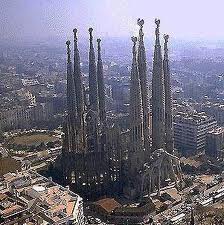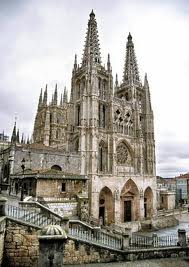Flamboyant Architecture
Societies across Europe suffered a dramatic transformation from the middle of the XIII to the middle of the XIV century, which in turn led to the questioning of some of the core values of Christianity. Spain was not immune to these changes, although the transition that took the continent out of the fold of of the feudal system and into the Humanism of the Renaissance was kept in check in the peninsula by a rare fondness for the old style, turned into Flamboyant architecture.

Among the many elements at play in the crisis that led to the end of the Middle Ages counts the erosion of the absolute power of monarchies, which had to rely more heavily on the bourgeoisie for funds and on the nobility for military and ultimately political support, as well as the persistent state of misdemeanor within the Church, where the leading factions, be those Cluniac, Cistercian or whatever else, repeatedly fell foul of their own standards.
Black Death
Most importantly, however, there was the outbreak of the the Black Death, a pandemic of colossal proportions that from 1347 to 1350, reached practically every corner of the continent, halving its population. Thus, the social, political and economical realities of Europe as it resurfaced from the calamity of the plague were such that the established order in every aspect was about to be challenged
In Italy this led to a naturalism that planted the seeds of the Renaissance. Castile, however, the dominant kingdom in the Iberian peninsula, would soon engage in a bitter civil war that, in turn, got the kingdom involved in the Hundred Years' War and sunk the country in an armed conflict that lasted well over a decade.
Within this uncertain environment, the development of novel artistic tendencies was rather stagnant, turning the marked Flemish presence derived from the growing trade between the two provinces into the dominant aesthetic proposition in Castile during the XV century. Thus, new projects, such as the cathedral in Seville will display what is known as Flamboyant, a variant of Gothic architecture where structural concerns are cast aside in favour of ornamental elements.
Still today, if you visit Seville, on a day trip from Cordoba, you will be able to recognise the highly decorated style of the building, one of the largest religious constructions in Christendom. Built on three levels, the exterior is dominated by the many flying buttresses, on two different levels, that give way to huge stained glass windows. On a side, the old minaret of the previous mosque has been converted into a bell tower, while every corner and gable is enhanced with pinnacles and patterns.
One development that did take roots in Spain in the XV century was the individualisation of artists. Thus, the fist recognisable figures begin to emerge in the peninsula, such as Hanequin of Brussels, whose influence is palpable in the Cathedral of Toledo, expanding the main facade, building the Door of the Lions and fitting the tower with arrows, pinnacles and further Flamboyant gadgets.

The wave of northern artists arrived in Castile towards the middle of the XV century also included Hans of Cologne, who was appointed to carry out further work on the Cathedral of Burgos. His additions included pyramidal pinnacles on the towers, the construction of the octagonal spire, modifications to the facade and the erection of the Chapel of the Visitation.
Hans' influence on the future development of the Flamboyant and ultimately Isabelline styles in Spain would be substantial, not only due to the notoriety of his work but also because he established a dynasty of architects of sorts with his son, Simon, who acted as master builder at Burgos Cathedral from 1481, where he built the Constable chapel, and his grandson, Francis, who often worked with his father, Simon.
Along with Hans of Cologne, Enrique Egas stands out as the most accomplished exponent of Flamboyant architecture in Spain. Son Egas Cueman, a Flemish artist arrived roughly at the same time as Hanequin of Brussels and Hans of Cologne, Enrique Egas worked on the Cathedral of Toledo from 1495, rebuilding the Mozarabic chapel. Nevertheless, his most remarkable work focused on the layout of hospitals, and his findings are said to have influenced the layout of El Escorial years later.
The most important artist of this period, however, is probably Juan Guas, who was in charge of building the Franciscan Monastery of San Juan de los Reyes in Toledo from 1477 onwards. A monumental enterprise intended to serve as Royal Mausoleum, the monastery consists of a single-nave church held by solid buttresses, equipped with an ornate octagonal spire and decorated with pinnacles and chain links that allude to the Christians freed by the Catholic Monarch's struggles in their culmination of the Reconquista.
Inside, the church building is split into eight chapels, with high rib-vaulted ceilings and imposing archeries. The wooden roofs are decorated in Mudéjar style with the crest of the Catholic monarchs and intricate patters that include eight-point stars. Like so many of the monasteries built ar the time, the two-storied cloister, with its typically Flamboyant gables along the pointed archery, is remarkable.
